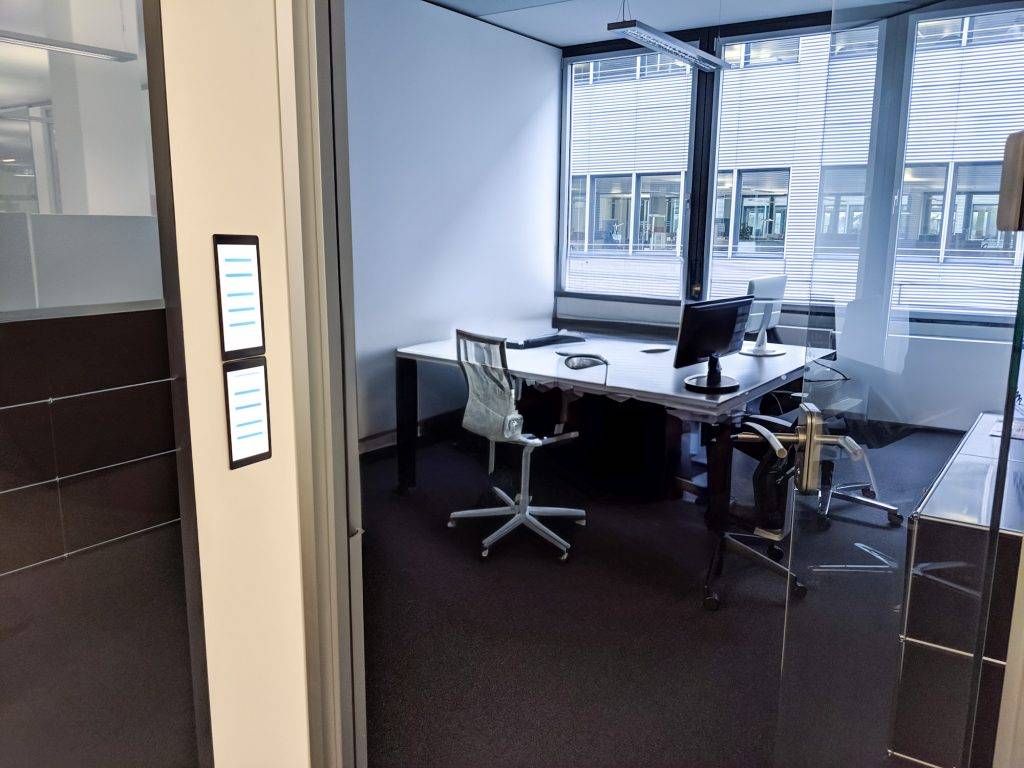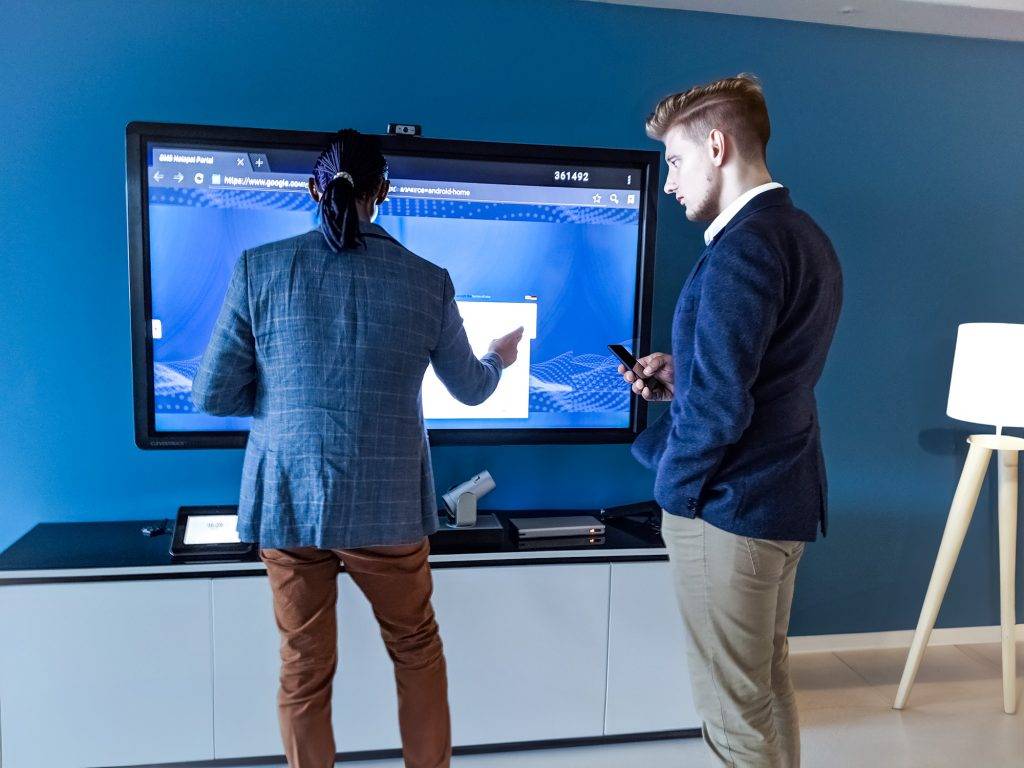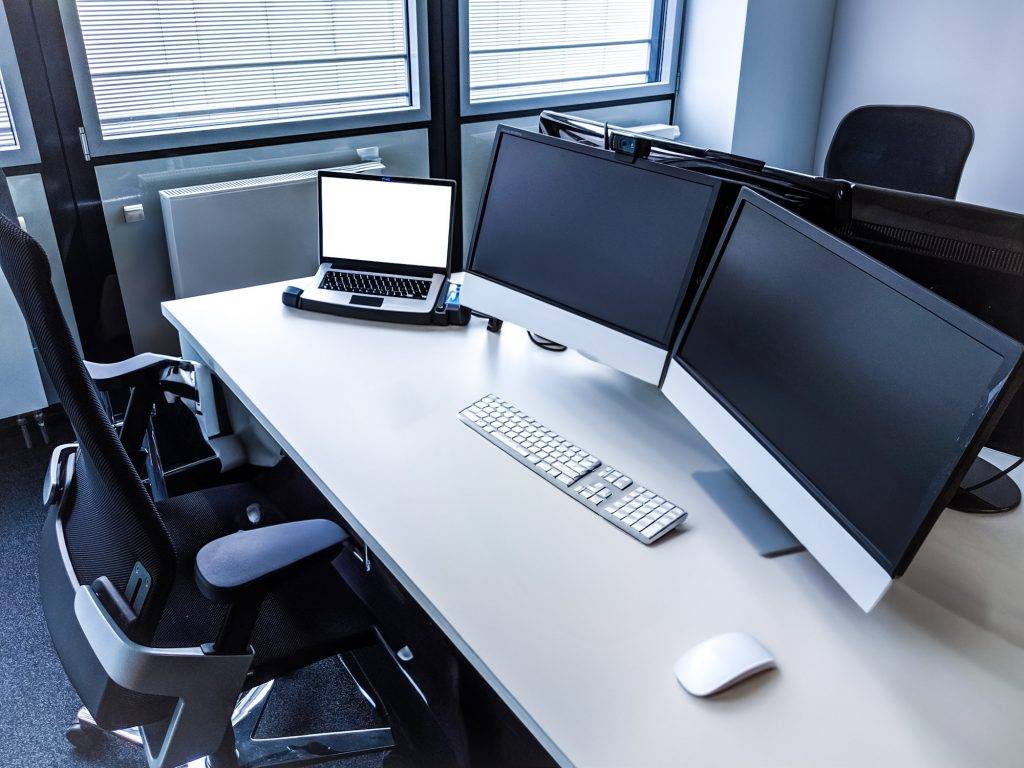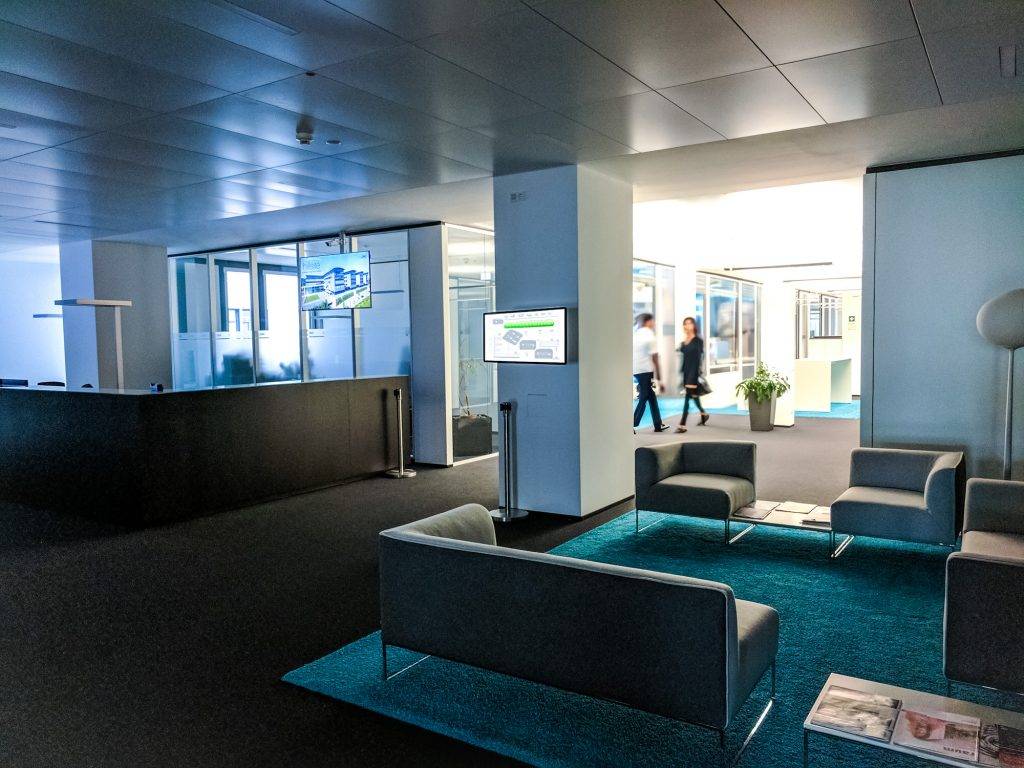
Looking for a desk-sharing app? No problem! Find it on the App Store and get started right away. But does it always lead to the desired outcome? The hybrid workplace has become the new normal for many companies as employees work from home and other locations. In this new model, the shared use of workspaces is losing significance for several reasons. Companies are realizing they have too many workstations, and with many employees not returning to the office after the pandemic, booking a workspace becomes an additional obstacle.
Contents:
- How has this developed?
- Why is it relevant to optimize the workplace experience?
- One-Stop-Shop: a good thing or a thing of the past?
- What does the available data indicate?
- What are the challenges associated with a desk-sharing model?
- Different Types of Collaboration
- Having no office is not a solution for everything
- Sustainability and environmental consciousness go beyond mere marketing tactics
- Summary
On the other hand, booking meeting rooms remains a necessity for many businesses, which poses its own challenge in managing limited resources. To enhance the efficiency and comfort of the hybrid workplace, smart buildings are gaining popularity. They provide guidance and foster better collaboration. smart buildings allow companies to easily manage who is in the office and what resources are available now and in the future.
How has this developed?
The rise of the hybrid workplace has been driven by the accelerated digital transformation experienced by many companies in recent years. As organizations seek to increase productivity and reduce costs, remote work has become an attractive option as it relieves employees of the need to commute to the office. However, amidst the rapid digital transformation, many long-term considerations were overlooked or not addressed in a timely manner.
We now find ourselves in a situation where we can easily download a simple workplace booking app from the App Store, but the scarcity of workspaces, which would make such a pure desk-sharing app more or less redundant depending on its functionality, is not the current problem faced by many offices. This problem needs to be approached in a differentiated and sustainable manner to optimize the workplace experience for the workforce.
Flexible work models have a significant impact on the requirements for facility management software. In a traditional office environment, employees were able to reserve their desks in advance using desk reservation apps. However, with the advent of flexible work models and the increasing encouragement for employees to work from home or other locations, these apps are losing relevance. Instead, companies are turning to intelligent facility management software that enables them to better manage their resources and occupancy levels to ensure a safe and comfortable working environment for all.
Why is it relevant to optimize the workplace experience?
With the increasing adoption of the hybrid work concept, it becomes crucial for companies to optimize the workplace. This includes ensuring that employees have a smooth transition back to the office and can easily navigate unfamiliar environments. It also means addressing common issues such as no-shows in meeting rooms, fostering a sense of community, and overall enhancing the everyday work experience.
Smart buildings and digital retrofits can provide solutions to many of these aspects, offering a more efficient and productive approach to resource and personnel management. Smart building features like automatic room booking, digital wayfinding, and touchless access control can facilitate employees in orienting themselves in unfamiliar buildings, quickly locating colleagues or resources, and collaborating efficiently. However, the added value extends beyond individual use cases.
One-Stop-Shop: a good thing or a thing of the past?
While various entities in the B2C sector continue to strive for a mega-app that does everything, a similar trend has been observed in the B2B realm for several years now. Consolidation of technical services and solutions has become part of the strategy for many international organizations, especially since the advent of the cloud. Aside from the potential vendor lock-in, the benefits of consolidation often outweigh the drawbacks on the agendas of CIOs and CTOs.

It’s interesting to note that many use cases related to the modern workplace don’t actually require direct user involvement. The optimal value often stems from automations and the achievement of objectives without the need for employee intervention. Furthermore, in a smart building, users can still be assigned certain rights based on their roles, enabling them to access information and interact with their workspace and colleagues.
What does the available data indicate?
According to an article by Microsoft, it is well-known that in the future, 70 percent of employees plan to work remotely and flexibly. Due to the pandemic, virtual meetings and digital teamwork have become necessary aspects of our work lives. The physical office is no longer as crucial for knowledge work since productive work can be done from anywhere, provided the IT infrastructure is in place. However, in order to be productive, creative, and satisfied, people still require social interaction. As a result, despite the benefits of working from home, 67 percent of employees desire more personal collaboration. The main challenge for companies lies in managing the simultaneity and differences between these two worlds.
With the rising popularity of hybrid workplaces, it is evident that companies must adapt their strategies and resources to accommodate this new model. The concept of shared desks is decreasing in significance as employees can work remotely, resulting in unutilized workspaces. While the booking of meeting rooms remains essential, these spaces too become limited resources. Smart buildings can offer a solution to these challenges by allowing companies to control office occupancy both now and in the future, while also providing guidance and fostering better collaboration. Companies that embrace this new technology will be better prepared for the future of work.
What are the challenges associated with a desk-sharing model?
Let’s take a moment to explore some subtopics that are frequently brought up by our customers.
Who will be in the office tomorrow?
While the shared desk model is still prevalent in many companies, its significance is diminishing with the rise of hybrid work. One of the main challenges lies in the difficulty of managing who will be in the office on a given day. For instance, is it worthwhile to come to the office if my entire team is working from home or remotely that day? Probably not.
Therefore, one primary approach is to shift focus from a mere desk booking app to a holistic workplace experience. Such an app should provide users with insights into when, where, and how everyone works, enabling informed decisions on how to collaborate productively on any given day.
Where can I find what I’m looking for?
Another crucial aspect that is sometimes overlooked is orienting and navigating within unfamiliar offices. It’s great to have reserved a desk or meeting room through a booking app, but how do you actually find your way there? Perhaps you’ve experienced this feeling too and wished for something like Google Maps for indoor spaces.

Even when it comes to other points of interest (POI) and not just the desk, this navigation feature can save minutes of searching and provide individuals with the right information for their specific location. Such functionalities assist employees in navigating unfamiliar environments and are not only a great feature for guests but also an integral part of a Workplace Experience App and solution.
The Dilemma of No-Shows
The “no-shows” is one of the most common challenges faced in the workplace. A “no-show” occurs when someone books a meeting room but fails to attend or neglects to cancel the reservation in advance. This can lead to significant disruptions for companies, resulting in productivity loss, wasted resources, and additional costs. The problem becomes particularly acute for hybrid teams, where employees work in different locations and may not always be able to cancel a meeting room reservation.
Smart buildings offer a solution by sending notifications when a meeting room is booked but left unused. This allows companies to quickly adjust their resources accordingly. Alternatively, other types of automation can be implemented, such as automatically releasing the booking if no one enters the meeting room within a certain period of time.
Different Types of Collaboration
Companies create an appealing office environment without sacrificing the benefits of hybrid work or home-office setups. To achieve this, they should focus on establishing a secure and flexible workspace that fosters collaboration and emphasizes community spirit. Employee amenities that are highly valued include access to natural light, comfortable furniture, ergonomic workstations, and breakout areas.
Smart building solutions can facilitate these amenities and create a more efficient and productive workplace. Leveraging data-driven insights about the office environment, companies can gain valuable information on how their employees utilize space and resources, as well as their preferred work styles. Armed with these insights, companies can develop meaningful strategies that enhance the work environment for everyone.
Having no office is not a solution for everything
Hybrid work models, where employees alternate between working in the office and remotely, are becoming increasingly popular. While abolishing the office may seem like an appealing option for many companies, it is important to consider the potential drawbacks of such a move.
Firstly, although remote work offers convenience and flexibility to many employees, it also presents some potential disadvantages. These include limited personal collaboration, decreased work morale, and challenges in contacting colleagues. Moreover, the absence of a physical workspace can lead to a sense of isolation for employees who benefit from social interactions during their workday.
Secondly, companies should consider how a fully virtual work arrangement might impact their culture and their employees’ experiences. Without a physical office, companies often struggle to create an environment that fosters collaboration and camaraderie. The workplace atmosphere can contribute to engaging employees and motivating them to perform at their best.

According to a McKinsey report, about 40% of respondents have accepted their current jobs due to the flexible working options available. This highlights the importance of creating an efficient, productive, and supportive environment to attract top talent As the world of work continues to evolve, companies must find solutions that benefit both their operations and the satisfaction and engagement of their employees. Essentially, a “Sticky Workplace” is described here, where companies could introduce new approaches to scheduling, staffing, and hiring innovation. For example, they could implement a lunchtime shift or allow individuals to form their own teams for projects instead of assigning them to predetermined groups.
One retailer simplified its application process for new candidates to shorten hiring time and rapidly expand its workforce. Other companies could enable applicants to test roles for a limited period or directly interview potential colleagues in the areas of the company that most interest them. Lastly, it is important for companies to evaluate the impact of desk-sharing or hot-desking policies. Hybrid models may present challenges related to safety, space management, and resource availability. Companies should also consider cost savings associated with such measures, especially for those with an excess of workspaces.
Sustainability and environmental consciousness go beyond mere marketing tactics
Smart buildings are an excellent tool for reducing a company’s ecological footprint. By leveraging data-driven insights, these intelligent structures optimize energy consumption and promote resource efficiency. For instance, platforms can automatically adjust temperatures based on occupancy or schedule lighting to turn off when offices are vacant. These measures not only reduce energy costs and CO2 emissions but also enhance a company’s sustainability profile.
Furthermore, smart buildings supported by machine learning (ML) offer benefits beyond simple office bookings. ML-powered algorithms can identify patterns in space utilization, enabling businesses to optimize resources and lower energy expenses. The hybrid work model presents both opportunities and challenges for organizations. However, those who take the time to assess their office environment and leverage smart building solutions can create a workspace that aligns with their business needs and promotes employee well-being. This approach resonates with workforce priorities and reflects the values of many leading companies worldwide.
Summary
The value of optimizing the workplace for businesses extends beyond individual use cases. Smart building applications such as automated room booking, digital wayfinding, and touchless access control not only ensure a smoother transition back to the office but also enhance teamwork and communication. This not only boosts employee morale but also increases productivity. Moreover, innovative solutions like real-time occupancy analytics provide valuable insights into how employees utilize office space, enabling informed decisions for space optimization.
Each individual perceives and experiences “work” differently, and every company, culturally speaking, is the sum of its individuals. Therefore, there is no one-size-fits-all optimal approach. However, many aspects are similar, and even if not every aspect is applicable to everything and everyone, it is important to consider these points carefully, even if the focus on workplace experience may shift later. The modern workplace will continue to be a blend of physical and digital environments for some time. Companies that embrace this transformation with intelligent building technologies ensure their employees have a seamless transition back to the office and an enhanced overall workplace experience. This positions them ahead when it comes to a successful long-term strategy for hybrid work – and beyond.